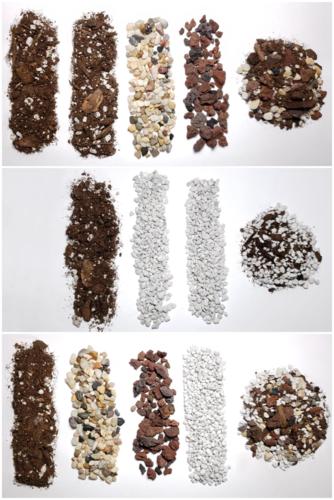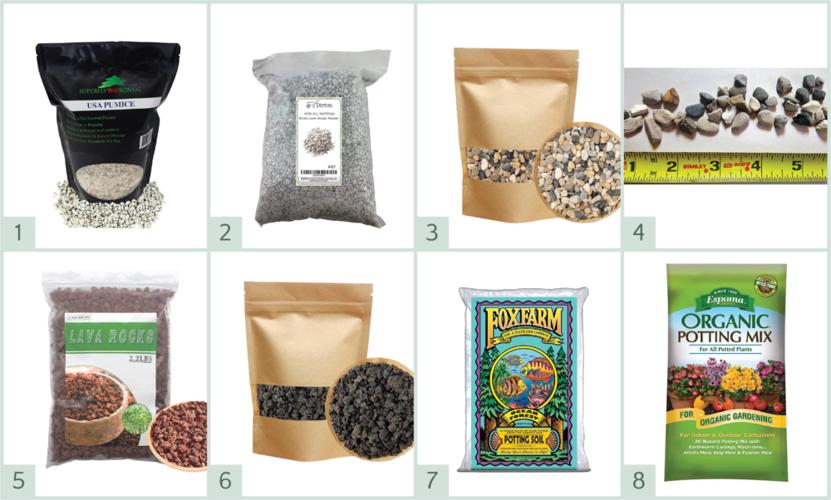June 15, 2022 by DementedDoll
Beginners Guide to Substrates for Succulents
From the perspective of an indoor environment with humid summers, informed by the generous teachings of everyone in the Succulents Discord community.
Substrate Components
Grit is the single most important portion of a succulent mix — it helps the substrate to stay airy and dry out quickly to avoid overwatering and root rot. Most grits will have about the same general effect but each has their own upsides and downsides. Whichever one(s) you can access will be fine — don't think you need to buy them all! Sand or any small grain grit can have the opposite of the desired effect as it compacts around the roots in a pot — retaining water and stunting root growth. I aim for grits about 3-10 mm in size. Wear a mask when working with any volcanic products!
-
Gravel — Most people should have access to this one in garden centres, home improvement stores or pet stores. If using aquarium gravel, I recommend finding an uncoated and unpainted product to avoid contaminating your soil when it eventually breaks down. Adds weight to your pot, and doesn't seem to improve drainage as much as porous grits.
-
Pumice — A personal favorite — light but not floaty, very airy, but hard to find in some places. Great for drainage.
-
Scoria (lava stone) — Similar to pumice but usually rougher and heavier. Roots love rough stone!
-
Perlite — Widely available and very affordable. Very light and may migrate to the top of your substrate over time, may blow away. Crumbles easily.
-
Misc — Anything chunky, not water retentive and that won't alter your soil in ways you don't intend (such as limestone which will affect pH) can be used as grit! Stuff like chicken grit, orchid bark, broken up old pots, broken leca, or busted up lava rocks they sell for the BBQ.
Above are examples of ways to reach common ratios.
Top row: two parts potting mix, gravel and scoria make up a 1:1 ratio of potting mix to grit.
Middle row: one part potting mix to two parts pumice make up a 1:2 ratio of potting mix to grit.
Bottom row: one part potting mix, one part gravel, one part scoria and one part pumice make up a 1:3 ratio of potting mix to grit.
For the second portion of your mix, any store-bought cactus/succulent potting mix or general potting mix (avoid ones labeled ‘water retaining’) will do the trick, but try to avoid heavy amounts of sand in the mix. Miracle-Gro products are generally avoided because of the high levels of fertilizer added to their products — when it comes to succs, slow steady growth is strong sturdy growth, and scarce nutrients are an important part of that goal. Coco coir can be used as an alternative to potting mix.
The classic ratio to start with is 1:1 — that is, half soil and half grit. The aim should be to have your substrate fully dry in about 3 days after watering. Depending on your climate, environment, and which plant you're potting, you may need to add more grit. For instance, things like Haworthia or Aloinopsis will need grittier soils than Peperomia or Jade plants, and cooler humid environments will need grittier soils than hotter arid environments. Talk to others with the same plant to get ideas! Images of your plant in habitat and climate data can also provide clues on how best to care for your plant. Take note if your plant requires specific nutrients or pH range in its soil which may require amendments. Research is for cool kids, join the club. 😎
Products pictured above and available in Canada:
Plant Collective Pumice, Marina Decorative Natural Gravel, WillGrow Small Lava Rock, FoxFarm Ocean Forest Potting Soil
Similar products available in the US. Garden Revival may earn a small commission if you buy from these links.
Tips
-
Individual pots for each plant are recommended for beginners to make it easier to apply different care to each plant.
-
Always use a pot with a hole that leaves about 15-25 mm of space on each side of your root ball.
-
Use fans — Indoor plants don't have wind to discourage fungi and help their substrate dry, make your own wind!
-
Never put a layer of rocks in the bottom of your pot, it actually makes drainage worse by creating a raised perched water table.
-
Top dressing can help the bottom of your plant avoid touching wet soil, but also impedes evaporation from your substrate. Use caution and adjust your soil accordingly to accommodate.
-
Rinse your grit before using it to cut down on dust and wash away any contaminants used in processing it.
-
I have found that substrate mixes more evenly when it contains varied weights of grit, such as a combo of gravel and pumice, and variation in grit size encourages stronger roots. For these reasons I like to make a mix with gravel, pumice and scoria in my soil.
Examples of simple to more advanced mixes
-
Peperomia ferreyrae planted in one part potting mix, one part pumice.
-
Aloe ‘Christmas Carol’ planted in one part potting mix, two parts gravel.
-
Echeveria ‘NN’ planted in one part potting mix, two parts gravel, two parts pumice.
-
Aloe striata planted in one part potting mix, one part clay, one part pumice, one part gravel.
-
Oxalis gigantea planted in one part potting mix, one part gravel, three parts very coarse sand, one part clay.
-
Dinteranthus vanzylii planted in one part loam-based potting mix, one part perlite, one part pumice, one part scoria, one part gravel, two parts crushed inert stone.
Happy potting!




